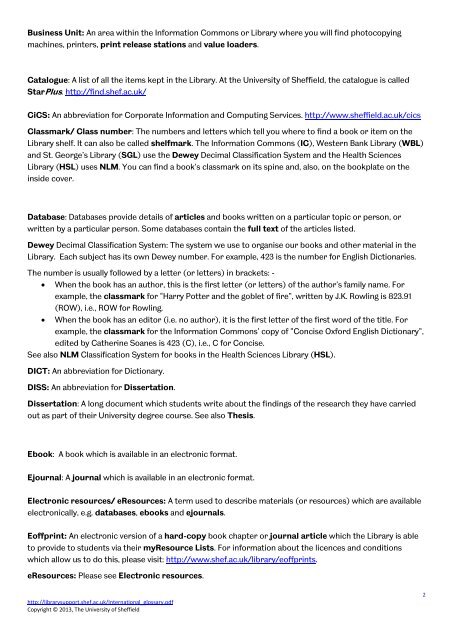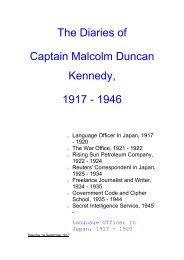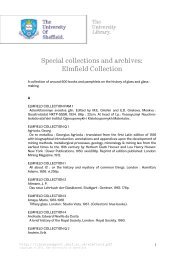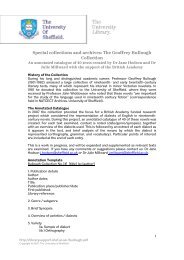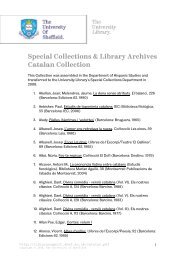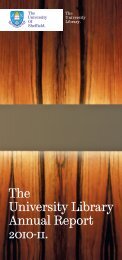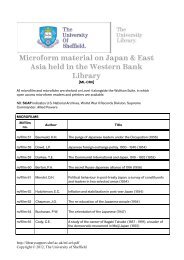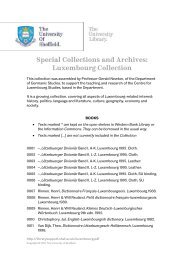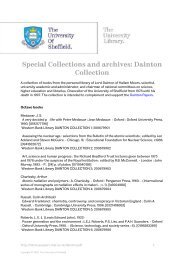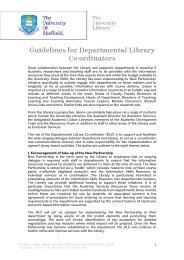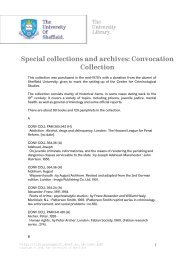Library Glossary - Temporary Home Page - University of Sheffield
Library Glossary - Temporary Home Page - University of Sheffield
Library Glossary - Temporary Home Page - University of Sheffield
You also want an ePaper? Increase the reach of your titles
YUMPU automatically turns print PDFs into web optimized ePapers that Google loves.
Business Unit: An area within the Information Commons or <strong>Library</strong> where you will find photocopying<br />
machines, printers, print release stations and value loaders.<br />
Catalogue: A list <strong>of</strong> all the items kept in the <strong>Library</strong>. At the <strong>University</strong> <strong>of</strong> <strong>Sheffield</strong>, the catalogue is called<br />
StarPlus. http://find.shef.ac.uk/<br />
CiCS: An abbreviation for Corporate Information and Computing Services. http://www.sheffield.ac.uk/cics<br />
Classmark/ Class number: The numbers and letters which tell you where to find a book or item on the<br />
<strong>Library</strong> shelf. It can also be called shelfmark. The Information Commons (IC), Western Bank <strong>Library</strong> (WBL)<br />
and St. George’s <strong>Library</strong> (SGL) use the Dewey Decimal Classification System and the Health Sciences<br />
<strong>Library</strong> (HSL) uses NLM. You can find a book’s classmark on its spine and, also, on the bookplate on the<br />
inside cover.<br />
Database: Databases provide details <strong>of</strong> articles and books written on a particular topic or person, or<br />
written by a particular person. Some databases contain the full text <strong>of</strong> the articles listed.<br />
Dewey Decimal Classification System: The system we use to organise our books and other material in the<br />
<strong>Library</strong>. Each subject has its own Dewey number. For example, 423 is the number for English Dictionaries.<br />
The number is usually followed by a letter (or letters) in brackets: -<br />
When the book has an author, this is the first letter (or letters) <strong>of</strong> the author’s family name. For<br />
example, the classmark for “Harry Potter and the goblet <strong>of</strong> fire”, written by J.K. Rowling is 823.91<br />
(ROW), i.e., ROW for Rowling.<br />
When the book has an editor (i.e. no author), it is the first letter <strong>of</strong> the first word <strong>of</strong> the title. For<br />
example, the classmark for the Information Commons’ copy <strong>of</strong> “Concise Oxford English Dictionary”,<br />
edited by Catherine Soanes is 423 (C), i.e., C for Concise.<br />
See also NLM Classification System for books in the Health Sciences <strong>Library</strong> (HSL).<br />
DICT: An abbreviation for Dictionary.<br />
DISS: An abbreviation for Dissertation.<br />
Dissertation: A long document which students write about the findings <strong>of</strong> the research they have carried<br />
out as part <strong>of</strong> their <strong>University</strong> degree course. See also Thesis.<br />
Ebook: A book which is available in an electronic format.<br />
Ejournal: A journal which is available in an electronic format.<br />
Electronic resources/ eResources: A term used to describe materials (or resources) which are available<br />
electronically, e.g. databases, ebooks and ejournals.<br />
E<strong>of</strong>fprint: An electronic version <strong>of</strong> a hard-copy book chapter or journal article which the <strong>Library</strong> is able<br />
to provide to students via their myResource Lists. For information about the licences and conditions<br />
which allow us to do this, please visit: http://www.shef.ac.uk/library/e<strong>of</strong>fprints.<br />
eResources: Please see Electronic resources.<br />
http://librarysupport.shef.ac.uk/International_glossary.pdf<br />
Copyright © 2013, The <strong>University</strong> <strong>of</strong> <strong>Sheffield</strong><br />
2


